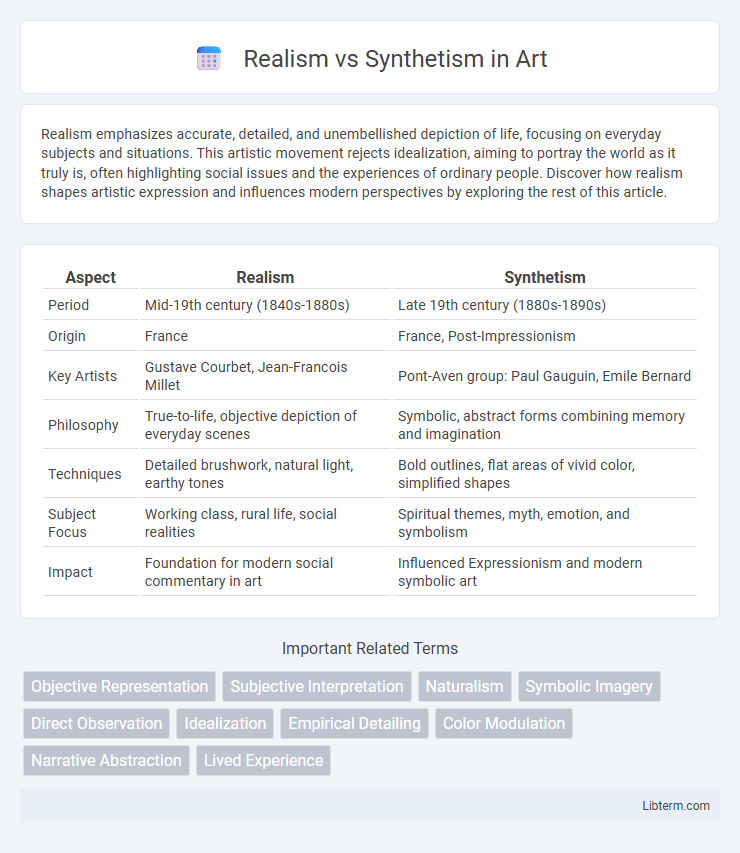Realism emphasizes accurate, detailed, and unembellished depiction of life, focusing on everyday subjects and situations. This artistic movement rejects idealization, aiming to portray the world as it truly is, often highlighting social issues and the experiences of ordinary people. Discover how realism shapes artistic expression and influences modern perspectives by exploring the rest of this article.
Table of Comparison
| Aspect | Realism | Synthetism |
|---|---|---|
| Period | Mid-19th century (1840s-1880s) | Late 19th century (1880s-1890s) |
| Origin | France | France, Post-Impressionism |
| Key Artists | Gustave Courbet, Jean-Francois Millet | Pont-Aven group: Paul Gauguin, Emile Bernard |
| Philosophy | True-to-life, objective depiction of everyday scenes | Symbolic, abstract forms combining memory and imagination |
| Techniques | Detailed brushwork, natural light, earthy tones | Bold outlines, flat areas of vivid color, simplified shapes |
| Subject Focus | Working class, rural life, social realities | Spiritual themes, myth, emotion, and symbolism |
| Impact | Foundation for modern social commentary in art | Influenced Expressionism and modern symbolic art |
Introduction to Realism and Synthetism
Realism emerged in the mid-19th century as an art movement dedicated to depicting subjects truthfully without idealization, emphasizing everyday scenes and ordinary people. Synthetism, developed by artists like Paul Gauguin in the late 19th century, focuses on synthesizing observation with the artist's emotions and symbolic use of color and form. While Realism prioritizes accurate representation and detail, Synthetism blends reality with imaginative elements to convey deeper emotional or spiritual meanings.
Historical Context of Both Movements
Realism emerged in the mid-19th century as a reaction against Romanticism, emphasizing accurate, unembellished depictions of everyday life and social conditions in response to industrialization and political upheaval. Synthetism developed later in the 1880s within the Post-Impressionist movement, particularly in Brittany, as artists like Paul Gauguin sought to synthesize form, color, and symbolism, rejecting both Realism's strict naturalism and Impressionism's focus on fleeting light effects. This shift reflected broader cultural currents toward symbolism and abstraction amid rapid modernization and shifting artistic paradigms in late 19th-century Europe.
Key Characteristics of Realism
Realism focuses on accurate, detailed, and unembellished depiction of everyday life, emphasizing ordinary people and social conditions. It avoids idealization, portraying subjects with a true-to-life approach that reflects objective reality and often highlights the socio-economic struggles. Key characteristics include a restrained color palette, naturalistic detail, and an emphasis on truthful representation rather than emotional or symbolic content.
Defining Features of Synthetism
Synthetism is characterized by the synthesis of form and color to convey symbolic meaning rather than mere visual accuracy, distinguishing it from Realism's emphasis on depicting subjects with lifelike precision. It integrates bold, flat areas of color, simplified shapes, and strong outlines to create an abstracted, decorative effect, often inspired by Paul Gauguin and Emile Bernard. This approach prioritizes emotional resonance and spiritual symbolism over realistic detail, marking a departure from Realism's faithful representation of everyday life.
Notable Artists and Works in Realism
Realism is defined by its commitment to depicting everyday life with truthful accuracy, highlighted by Gustave Courbet's "The Stone Breakers" and Jean-Francois Millet's "The Gleaners," which showcase rural labor and social realities. Honore Daumier's satirical works and Edouard Manet's "Olympia" challenge conventional norms and emphasize unidealized representations, distinguishing Realism from Synthetism's emphasis on symbolic colors and forms as seen in Paul Gauguin's works. Realist artists focus on detailed textures and muted natural palettes while Synthetism explores abstraction and vibrant hues, marking a distinct shift in 19th-century art movements.
Influential Figures in Synthetism
Paul Gauguin and Emile Bernard are pivotal figures in Synthetism, emphasizing bold colors and simplified forms over the detailed representation favored by Realism. Gauguin's innovative use of vivid hues and symbolic content contrasted sharply with Realism's focus on depicting everyday life with meticulous accuracy. Bernard's contributions helped define the movement's characteristics, influencing Post-Impressionism by prioritizing emotional expression and abstract design.
Philosophical Differences: Objective vs. Subjective
Realism emphasizes an objective representation of reality, aiming to depict the world as it exists independently of the observer's emotions or interpretations. Synthetism embraces a subjective approach, prioritizing personal expression, emotions, and symbolic meanings over literal accuracy. This philosophical divide highlights Realism's commitment to factual truth versus Synthetism's focus on individual perception and artistic synthesis.
Techniques and Use of Color
Realism emphasizes accurate, detailed depictions of everyday scenes using natural hues and careful shading to create depth and texture. Synthetism, pioneered by artists like Paul Gauguin, employs bold, flat colors and simplified forms to convey emotional and symbolic meaning rather than precise representation. Techniques in Synthetism favor broad color areas and outlines, contrasting with Realism's meticulous brushwork and tonal gradation for lifelike effects.
Impact on Modern Art Movements
Realism's dedication to depicting everyday life with accurate detail laid the groundwork for later movements like Impressionism and Social Realism by emphasizing authenticity and social commentary. Synthetism, pioneered by artists such as Paul Gauguin, introduced bold colors, simplified forms, and symbolic content, significantly influencing Post-Impressionism and paving the way for movements like Fauvism and Expressionism. Together, Realism and Synthetism challenged traditional representation, fueling the evolution of modern art through their contrasting approaches to color, form, and subject matter.
Realism vs Synthetism: Lasting Legacy
Realism and Synthetism both shaped modern art by influencing how artists represent reality and emotional expression. Realism's lasting legacy lies in its commitment to depict everyday life with accuracy and social commentary, inspiring subsequent movements like Naturalism and Social Realism. Synthetism advanced symbolic use of color and form, paving the way for Post-Impressionism and abstract art, demonstrating a lasting impact on the evolution of visual language.
Realism Infographic

 libterm.com
libterm.com